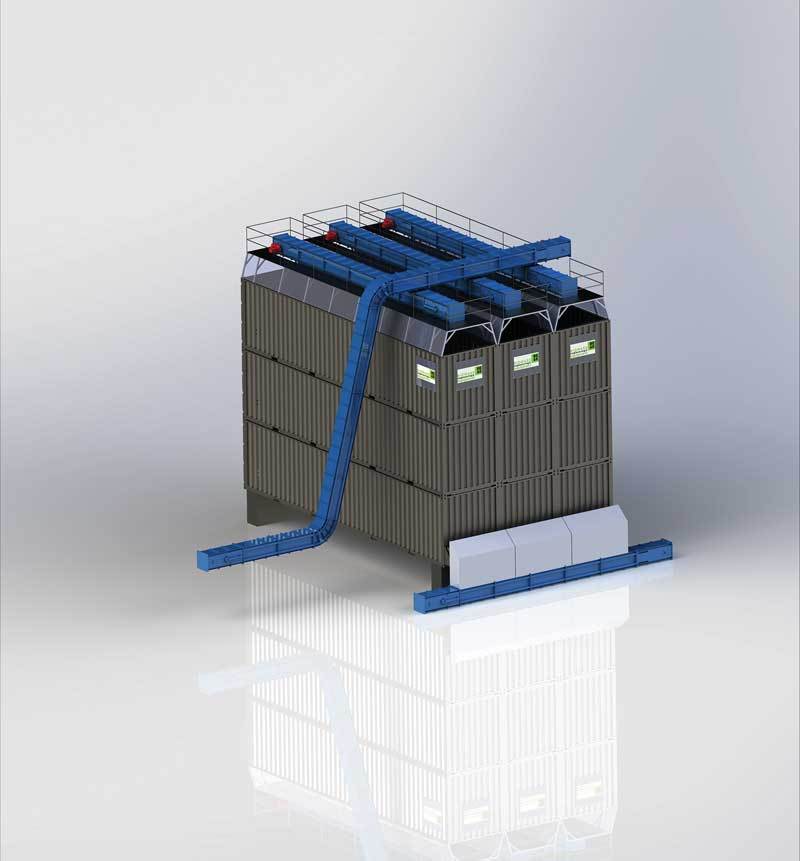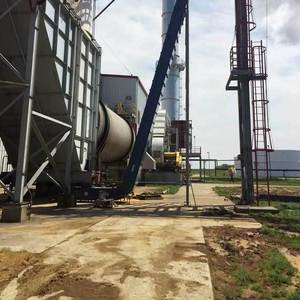DDGS: Options to Optimize



PHOTO: BIOMASS ENGINEERING & EQUIPMENT
April 12, 2019
BY Joel Dulin
Richard Kloster, senior vice president at AllTranstek, a logistics provider for the rail sector, says the rail car surplus decreased by 29 percent in 2018 as demand increased 3 percent. He projects demand will rise in 2019.
Unreliable transportation is troublesome for ethanol producers. When rail cars arrive late, ethanol producers sometimes approach capacity limits for dried distillers grains with solubles. This difficulty compounds year by year as plants make more DDGS.
Producers not only need more storage, they require more from it. In an effort to better monetize DDGS, producers are developing multiple lines of it. Some now pelletize it. Separate products, of course, require divided storage.
Typically, producers will divide storage (and thereby solve the capacity issue) by adding infrastructure, such as a silo. Such an undertaking is expensive, however, and does not address problems associated with traditional DDGS storage, such as wheel loader expenses and animal infestations in the storage building.
Older ethanol facilities face a third material handling problem: aging, inefficient conveyor systems they must soon replace.
Advertisement
Rather than dealing with these issues piecemeal, producers should tackle them together. Three options for doing so include optimizing the setup of the current DDGS storage building, using container bins with moving floors to add capacity, and extending the storage building and automating loadout.
Additional Chutes
To optimize their current storage building, producers can add chutes between the current openings of the conveyor that dumps DDGS onto the floor. Better yet, they can replace this conveyor with a newer, more efficient model with extra chutes. Additional chutes will allow DDGS to form more of a ridge. Alternatively, producers can add perpendicular conveyors off the main conveyor. These conveyors will allow DDGS to form wider piles and fill in the space between the center piles and retaining wall. A third option is to add a conveyor in or over the storage building that runs parallel to the existing conveyor. This second conveyor will widen the piles and fill in gaps between the piles or between the piles and the retaining wall.
The limitation to these options is that they will not divide producers’ storage. They also will not truly add capacity. They will just better utilize the current storage space. They may also only free up enough capacity to help producers get by a few extra days, at most, if rail cars come late for pickup.
Container Bins
A second option to increase storage and address aging conveyors is to install container bins with moving floors, and conveyors that service them. Ethanol producers can place these bins outside the current storage building and stack them to increase vertical storage space. Producers can use the bins to divide their storage as well.
The primary benefit of a container-based system is that it adds capacity without the capital investment of a silo. Not only do moving-floor containers cost less up front, but they depreciate faster than silos because they are machines, not buildings.
Another benefit is automated discharge. A producer with moving-floor bins will not have to use wheel loaders to fill rail cars or a loadout pit. If a producer opts to add enough bins to replace their storage building, they can stop using their wheel loader and utilize the storage building for another purpose. Exclusively using bins for DDGS storage can also potentially reduce what producers pay in insurance, as they will eliminate the agricultural explosive environment of the storage building. Plus, producers can maintain the bins and the conveyors feeding them with standard tools, which will reduce operational expenses.
Producers may opt to place their container bins inside their storage buildings rather than outside. It is possible the containers might eliminate the explosive environment in this setup, and the setup will help regulate DDGS temperature during winter months. However, it will require producers to shut down production while a crew installs the containers and new conveyors.
Advertisement
But container bins retain heat. So, ethanol producers who rely on wheel loaders to move around DDGS so they can cool cannot use containers for storage. To utilize the bins, these producers will have to install a post-dryer cooler or an oscillating deck conveyor to cool their DDGS before storage.
Automated Loadout
A third option for optimized storage is to extend the current DDGS building and add moving floors. The benefits of this setup are that it increases true capacity, utilizes current infrastructure, automates output, and eliminates the need for a wheel loader. It can be designed to allow for divided storage and be completed without interrupting operations.
Completion can occur in two stages. In the first stage, crews will construct the storage building addition and route a conveyor to it. In this addition, moving floors will direct DDGS to a loadout conveyor in the center of the floor. In the second stage, the new addition will handle DDGS storage while crews add moving floors, drags and a loadout conveyor to the original storage area.
Besides benefitting from the added capacity, producers can better utilize the space available in the building as a whole because they will use more of the floor space to store DDGS. They will not need space for a wheel loader to maneuver.
The downside to this option is that it does not eliminate the agricultural explosive environment. It also requires more capital investment than the container option. Furthermore, it prevents producers from moving around DDGS for cooling.
In an environment where tomorrow’s scheduled loadout is uncertain and where ethanol producers must operate more efficiently than ever, producers need solutions that decrease risks to production. They need solutions that decrease operational costs. Traditional solutions like silos and wheel loaders may resolve a producer’s challenges, but they will not do it as cost effectively as other methods. Solutions that ultimately benefit the bottom line, such as those outlined above, are worth considering.
Author: Joel Dulin
Digital Marketing Manager
Biomass Engineering & Equipment
317.346.0711
joel@veneerservices.com
Related Stories
Saipem has been awarded an EPC contract by Enilive for the expansion of the company’s biorefinery in Porto Marghera, near Venice. The project will boost total nameplate capacity and enable the production of SAF.
Global digital shipbuilder Incat Crowther announced on June 11 the company has been commissioned by Los Angeles operator Catalina Express to design a new low-emission, renewable diesel-powered passenger ferry.
International Air Transport Association has announced the release of the Sustainable Aviation Fuel (SAF) Matchmaker platform, to facilitate SAF procurement between airlines and SAF producers by matching requests for SAF supply with offers.
Alfanar on June 20 officially opened its new office in London, further reaffirming its continued investment in the U.K. The company is developing Lighthouse Green Fuels, a U.K.-based SAF project that is expected to be complete in 2029.
ATR and French SAF aggregator ATOBA Energy on June 19 signed a memorandum of understanding (MOU) to explore ways to facilitate and accelerate sustainable aviation fuel (SAF) adoption for ATR operators.
Upcoming Events










